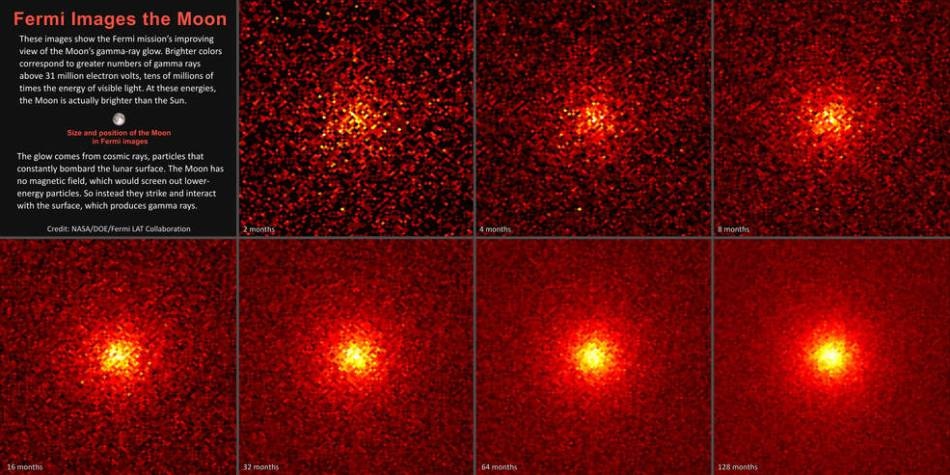Aug 19 2019
The Moon would seem brighter than the Sun if human eyes could see high-energy radiation known as gamma rays. This is precisely how the Moon has been observed in space by NASA’s Fermi Gamma-ray Space Telescope over the last 10 years.
 These images show the steadily improving view of the Moon’s gamma-ray glow from NASA’s Fermi Gamma-ray Space Telescope. Each 5-by-5-degree image is centered on the Moon and shows gamma rays with energies above 31 MeV, or tens of millions of times that of visible light. At these energies, the Moon is actually brighter than the Sun. Brighter colors indicate greater numbers of gamma rays. This image sequence shows how longer exposure, ranging from two to 128 months (10.7 years), improved the view. (Image credit: NASA/DOE/Fermi LAT Collaboration)
These images show the steadily improving view of the Moon’s gamma-ray glow from NASA’s Fermi Gamma-ray Space Telescope. Each 5-by-5-degree image is centered on the Moon and shows gamma rays with energies above 31 MeV, or tens of millions of times that of visible light. At these energies, the Moon is actually brighter than the Sun. Brighter colors indicate greater numbers of gamma rays. This image sequence shows how longer exposure, ranging from two to 128 months (10.7 years), improved the view. (Image credit: NASA/DOE/Fermi LAT Collaboration)
Gamma-ray observations are not adequately sensitive to evidently observe the shape of the Moon’s disk or any surface features. Rather, Fermi’s Large Area Telescope (LAT) spots a noticeable glow centered on the position of the Moon in the sky.
Mario Nicola Mazziotta and Francesco Loparco, from Italy’s National Institute of Nuclear Physics in Bari, have been studying the gamma-ray glow of the Moon to gain better insights into another type of radiation from space—cosmic rays, which are rapidly moving particles.
Cosmic rays are mostly protons accelerated by some of the most energetic phenomena in the universe, like the blast waves of exploding stars and jets produced when matter falls into black holes.
Mario Nicola Mazziotta, National Institute of Nuclear Physics–Bari
Since the particles are electrically charged, the magnetic fields (which the Moon lacks) has a strong impact on the particles. Therefore, cosmic rays even with low energy can reach the surface, transforming the Moon into a convenient space-based particle detector.
The cosmic rays that hit the Moon interact with its powdery surface, known as the regolith, to generate gamma-ray emission. Although the Moon absorbs a major portion of these gamma rays, some of them still manage to escape.
Through the analysis of Fermi LAT lunar observations, Mazziotta and Loparco demonstrate how the view has become better during the mission. They gathered data for gamma rays with energies more than 31 MeV—over 10 million times greater compared to visible light’s energy—and organized them over time, revealing the way longer exposures enhance the view.
Seen at these energies, the Moon would never go through its monthly cycle of phases and would always look full.
Francesco Loparco, National Institute of Nuclear Physics–Bari
With NASA intending to send humans to the Moon by 2024 by means of the Artemis program, with the ultimate aim of sending astronauts to Mars, gaining insights into different aspects of the lunar environment has achieved new significance. The gamma-ray observations point out that on the Moon, astronauts will need protection from the same cosmic rays that generate this high-energy gamma radiation.
Although the gamma-ray glow of the Moon is impressive and astonishing, the Sun shines even brighter in gamma rays with energies over 1 BeV. Cosmic rays that have lower energies do not reach the Sun since its strong magnetic field filters them. However, cosmic rays with much more energies can still pierce through this magnetic shield and hit the denser atmosphere of the Sun, generating gamma rays that can reach Fermi.
The gamma-ray Moon does not exhibit a monthly phase cycle, but there is a change in its brightness over time. Fermi LAT data reveal that the brightness of the Moon differs by roughly 20% over the 11-year activity cycle of the Sun. Changes in the intensity of the magnetic field of Sun during the cycle modify the rate of cosmic rays that reach the Moon, thereby altering the gamma-ray generation.